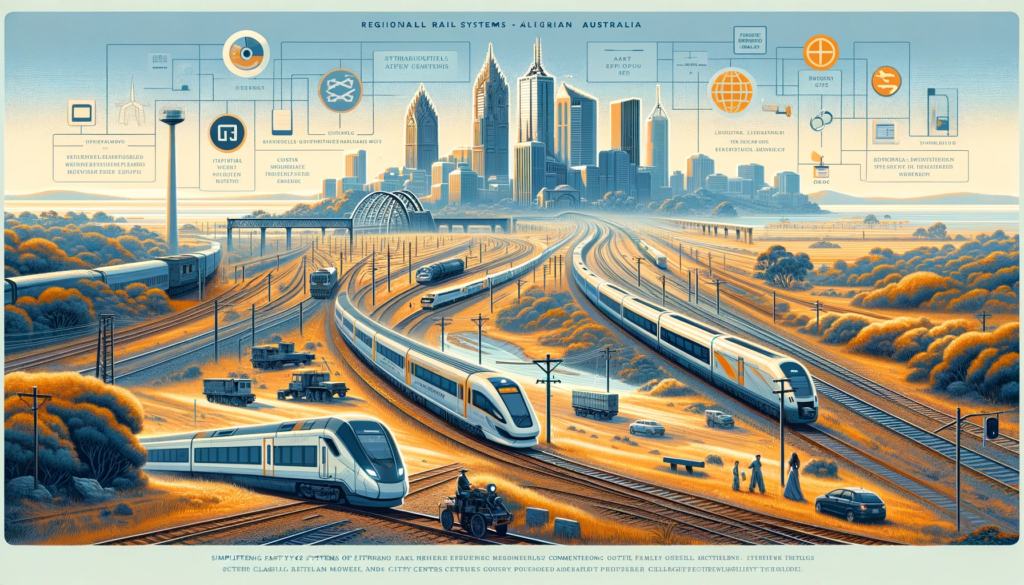This article aims to provide an overview of railway signalling trends in Australia. It is important to understand that Australia is not just a country but a whole continent with a great variety of railway systems much less coherent than those in Europe. Accordingly, there is a wide range of different signalling and train control systems in Australia. One could even see it as an almost unparalleled showcase of modern signalling and train control variety, and you may well agree with that view after reading this article.
You will know that Australia is an island, even though a very big one, and there are no railway connections with neighbouring countries. However, Australia itself is a federation of numerous states and territories with many different independent railway jurisdictions and some requirements for cross traffic between those different railways.
The states and cities that are best known elsewhere in the world are New South Wales with its capital city Sydney, Victoria with Melbourne, Queensland with Brisbane, Western Australia with Perth and South Australia with Adelaide.
Railway Networks and Signalling Pedigree
There are five very different categories of railway networks in Australia which indicates the variety I mentioned in the introduction.
- City railway networks, most comparable with suburban commuter services in European cities (for example the “S Bahn” in Berlin).
- Regional networks which connect the cities with regional subcentres in the same state. The vast majority of traffic on those networks are freight trains, since long-distance passenger rail traffic is much less common in Australia than in Europe.
- An interstate network which connects the five largest cities in Australia. It is only since 1996 that this interstate network enjoys a unified standard gauge track! The famous Indian Pacific between Sydney and Perth is one of very few passenger services on this network which is otherwise predominantly used for freight transport.
- Various dedicated (and often stand-alone) freight rail networks to connect mines with ports for export of raw materials. Typical examples are the iron ore railways in the Pilbara region of north-west Australia and the coal networks in Queensland.
- Separated tourist railways with heritage trains, for example “Puffing Billy” near Melbourne in Victoria.
The signalling history in Australia was hugely influenced by migration from different regions of the world with quite different preferences regarding railway systems: England, the USA and Ireland. This variety shows in three different rail gauges we still have in Australia: 1067mm narrow gauge in Brisbane and Perth and parts of their respective states, 1435mm standard gauge in Sydney and New South Wales, on the interstate network and for the mining railways in the Pilbara, and 1600mm broad gauge in Melbourne, Adelaide and parts of their respective states. The signalling systems were similarly diverse, with a colourful mixture of route and speed signalling and interesting “special effects” in signal aspects, to the point where the same aspect means ‘stop’ in one state and ‘proceed at line speed’ in another state. All that makes any attempts of nation-wide standardisation very “interesting”, to say the least.
This article is not so much about past railway history, but rather about current trends for signalling modernisation with advanced technologies for Automatic Train Control. So let’s focus on that from here on.
As a curious side note for your next railway trivia evening (if you are into that), Australia is probably the only country in the world which uses the term “train control” for what is everywhere else called traffic management. However, this article uses the term train control in its international meaning as in Automatic Train Control.
Technology Mix for City Networks
The four biggest Australian cities (Sydney, Melbourne, Brisbane and Perth) have all strong population growth which is expected to continue or even increase over the coming decades. For example, Melbourne is expected to reach the current population size of London over the next 30 years. Accordingly, the city rail networks are reaching their capacity limits, and higher signalling capacity is needed to keep up with future expectations for growing railway patronage.
Interestingly, the cities came to different technology preferences to address this capacity challenge. Sydney and Brisbane are introducing enhanced varieties of ETCS Level 2 (featuring ATO over ETCS, and in the case of Sydney also an integrated Traffic Management System comparable to the Automatic Train Supervision of CBTC), while Melbourne and Perth selected CBTC as preferred technologies. However, Melbourne plans to change their future signalling strategy to ETCS for better alignment with the other major cities on Australia’s east coast, Sydney and Brisbane. I will address the interoperability challenge briefly at the end of this article.
A special case in Sydney sees the introduction of an entirely new Metro network with unattended train operation in Grade of Automation 4 which of course uses CBTC for signalling. So Sydney has both CBTC and ETCS, but since the Metro and suburban networks are segregated there is no harm in having both technologies in the same city.
Just for completeness, Adelaide retained the existing signalling system and has introduced ETCS Level 1 for Automatic Train Protection, not having the expectation in added capacity demand as the four bigger cities.

Signalling Variety for Regional Networks
The regional networks in the various Australian states have evolved using different safety systems. Cost-efficiency is paramount for those vast networks with often very little traffic, and different forms of train order working with little classical signalling is the preferred technology for most lines.
The future signalling technology on those lines will depend on the use cases. There is a lot of talk about Regional Fast Rail connections between the major cities and their closest larger regional centres, for example Sydney-Newcastle in New South Wales or Melbourne-Geelong in Victoria. Since those fast rail services would run right into the city centres, it can be expected that those lines would be fitted with ETCS to achieve interoperability with the future signalling landscapes in Sydney and Melbourne respectively.
Bespoke Technology on the Interstate Network
The Australian interstate network has very remote parts that cry out for minimised need to maintain signalling equipment. ETCS did not seem to be the most suitable technology for this network, so the network operator decided instead to develop a derivative of the American Positive Train Control technology. Unfortunately, the “Advanced Train Management System” ATMS as they call their application, got decoupled from the American PTC standardisation and is now a bespoke development which is unique in the world. The expected operational benefits from that technology were huge, however the system development to date has not fulfilled the promised functionality, and now that the original technology developer pulls out of the Australian market it will be a major challenge to finish the system development to its full set of requirements and maintain it long-term.
Freedom of Choice for Mining Railways
The highly competitive climate between the mining giants in Australia’s north-west has led to the development of four entirely segregated railway networks, some of them running their tracks only 50 metres apart for many kilometres.
As for signalling, every operator sought to optimise signalling capacity with different technology. The most famous train control application in the Pilbara is Rio Tinto’s “AutoHaul”, dubbed the world’s largest robot and featuring driverless heavy haul freight trains between Rio’s various mine and port locations. Technically, AutoHaul is based on ETCS Level 2 components, but with many non-standard functional add-ons.
Coincidentally, another mining operator (Roy Hill) ended up with that same technology, only without the driverless feature, at least for the time being.
A third Pilbara mining operator, Fortescue Metals Group, opted for a product of the American PTC landscape to control their trains.
And the biggest miner of them all, BHP, is likely to end up with yet another bespoke solution developed to unique (and seemingly ever-changing) specifications. Curiously, they call it “CBTC” even though it has arguably little in common with the high-capacity CBTC used for city metros. But hey, it is communication-based and it does control trains!

But What About Interoperability?
Good question. There is massive concern that the great variety of different train control technologies currently introduced in different parts of Australia may cause “digital gauge breaks” which reduced interoperability rather than increasing it. The federal and state governments started to pay attention and collaboration agreements have been signed with the aim of improving interoperability between the various Australian railways, of course including interoperability of their signalling and train control technologies.
The biggest of many challenges there seems to be the need for an interoperability solution between the bespoke ATMS technology on the interstate network and the ETCS (and maybe also CBTC) applications in the city networks connecting to the interstate network. It took more than 15 years to come up with a concept how it could work, but time will tell whether the necessary development of a safety-critical “gateway” between the different technologies is achievable or remains a “nice idea” that will never get realised. It should not surprise that many people think about workarounds for different cities (local versions of a plan B so to say) just in case a technical solution for full interoperability may not be available in time.
In summary, the Australian market for modern signalling technologies enjoys a wonderful variety with something for every taste, and if you ever want to live and work in a country where the sun shines most of the time there is plenty of opportunity here.
—-
About the author:
‘Doc Frank’ is a globally known independent strategy consultant, trainer and thought leader for advanced “High Capacity Signalling”, including CBTC and enhanced varieties of ETCS Level “2 plus”. He lives in Perth on the sunny west coast of Australia, just close enough to the beaches for an enjoyable work-life balance.
His portfolio of training courses is famously suitable for railway people with or without prior signalling knowledge (https://docfranktraining.podia.com) and includes the “CBTC Kickstarter” as the longest-running public CBTC training in the world. He is host of the podcast “Railway Conversations with Doc Frank” and recently excelled in single-handedly organising the global virtual CBTC conference “CBTC World Summit” with 18 top-class speakers from 13 different countries.
Follow Doc Frank on LinkedIn to keep track of his next ventures.

 1 rok temu
1 rok temu